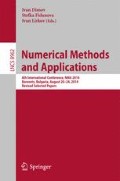Abstract
The signed-particle Monte Carlo method for solving the Wigner equation has made multi-dimensional solutions numerically feasible. The latter is attributable to the concept of annihilation of independent indistinguishable particles, which counteracts the exponential growth in the number of particles due to generation. After the annihilation step, the particles regenerated within each cell of the phase-space should replicate the same information as before the annihilation, albeit with a lesser number of particles. Since the semi-discrete Wigner equation allows only discrete momentum values, this information can be retained with regeneration, however, the position of the regenerated particles in the cell must be chosen wisely. A simple uniform distribution over the spatial domain represented by the cell introduces a ‘numerical diffusion’ which artificially propagates particles simply through the process of regeneration. An optimized regeneration scheme is proposed, which counteracts this effect of ‘numerical diffusion’ in an efficient manner.
Access this chapter
Tax calculation will be finalised at checkout
Purchases are for personal use only
References
Akhiezer, N.: The Classical Moment Problem: And Some Related Questions in Analysis. University Mathematical Monographs, Oliver & Boyd, London (1965)
Ellinghaus, P., Nedjalkov, M., Selberherr, S.: Implications of the coherence length on the discrete wigner potential. In: Abstracts of the 16th International Workshop on Computational Electronics (IWCE), pp. 155–156 (2014)
Karian, Z., Dudewicz, E.: Fitting Statistical Distributions: The Generalized Lambda Distribution and Generalized Bootstrap Methods. Taylor & Francis, New York (2010)
Nedjalkov, M., Schwaha, P., Selberherr, S., Sellier, J.M., Vasileska, D.: Wigner quasi-particle attributes - an asymptotic perspective. Appl. Phys. Lett. 102(16), 163113 (2013)
Nedjalkov, M., Vasileska, D.: Semi-discrete 2D wigner-particle approach. J. Comput. Electron. 7(3), 222–225 (2008)
Shohat, J.A., Tamarkin, J.D., Society, A.M.: The Problem of Moments. Mathematical Surveys and Monographs. American Mathematical Society, Providence (1943)
Acknowledgement
This research has been supported by the Austrian Science Fund through the project WigBoltz (FWF-P21685-N22).
Author information
Authors and Affiliations
Corresponding author
Editor information
Editors and Affiliations
Rights and permissions
Copyright information
© 2015 Springer International Publishing Switzerland
About this paper
Cite this paper
Ellinghaus, P., Nedjalkov, M., Selberherr, S. (2015). Optimized Particle Regeneration Scheme for the Wigner Monte Carlo Method. In: Dimov, I., Fidanova, S., Lirkov, I. (eds) Numerical Methods and Applications. NMA 2014. Lecture Notes in Computer Science(), vol 8962. Springer, Cham. https://doi.org/10.1007/978-3-319-15585-2_3
Download citation
DOI: https://doi.org/10.1007/978-3-319-15585-2_3
Published:
Publisher Name: Springer, Cham
Print ISBN: 978-3-319-15584-5
Online ISBN: 978-3-319-15585-2
eBook Packages: Computer ScienceComputer Science (R0)

